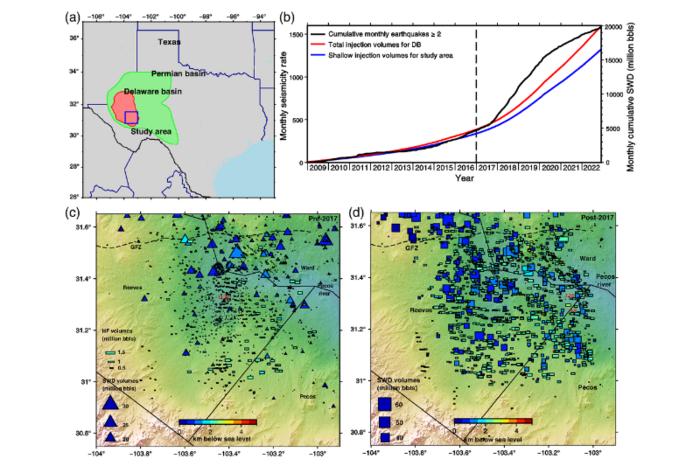DALLAS (SMU) – There’s an important dividing line in the history of recent Texas earthquakes – those occurring before and after 2017, when the establishment of the Texas Seismological Network (TexNet) introduced the ability to monitor seismic events to much lower magnitude.

Credit: SMU
DALLAS (SMU) – There’s an important dividing line in the history of recent Texas earthquakes – those occurring before and after 2017, when the establishment of the Texas Seismological Network (TexNet) introduced the ability to monitor seismic events to much lower magnitude.
A new study by SMU seismologists reexamines earthquakes in the Permian Basin that occurred before 2017 against the real-time data collected from earthquakes taking place after 2020. Results confirm that the seismicity occurring from 2009-2017 was causally linked to the underground injection of wastewater that is a byproduct of oil and gas extraction. The study presents advanced earthquake location methods that significantly revises estimated depths of the earlier seismicity and shows that, like events that occur now, the earlier earthquakes in the Basin occurred in or near the units of shallow depth wastewater injection.
The findings appear in The Seismic Record, a Journal of the Seismological Society of America, under the title Insights into Temporal Evolution of Induced Earthquakes in the Southern Delaware Basin Using Calibrated Relocations from the TXAR Catalog (2009–2016). SMU postdoctoral researcher Asiye Aziz Zanjani is the lead author. Heather DeShon, department chair for SMU’s Roy M. Huffington Department of Earth Sciences, is a co-author with collaboration and funding support from the TexNet program at the University of Texas.
Over the past decade, the Permian Basin, west Texas and southeastern New Mexico in the United States, has become the world’s leading petroleum producer using hydraulic fracturing. The basin is divided into the western Delaware Basin, Central Basin Platform and eastern Midland Basin.
This research focuses on the Delaware basin, south of the Grisham fault zone, where earlier work had indicated that earthquakes began circa 2009, when hydrofracking and wastewater injection began to increase significantly, but lack of seismic stations had limited more detailed understanding. During hydrofracking a mixture of water, sand, and chemicals are injected deep into the ground to create fractures that improve oil and gas extraction. Then, along with the oil and gas, natural waters from the formation and fluids used in the hydrofracking return to the surface.
The wastewater has to be disposed of, and injecting it into disposal wells targeting rocks that can hold the additional fluids, is a common tactic. In the Delaware Basin, injection takes place into formations at 0.5-3 km depth surface (shallow) and at 4-6 km depth (deep), with hydrofracking occurring at depths in between. In this scenario, accurate earthquake depths provide a key to understanding triggering.
Using a method called Hypocentroidal Decomposition, Aziz Zanjani calculated more accurate locations for the pre-2017 earthquakes by linking older data to the highest quality, newer TexNet data. The new locations reveal a spatial and temporal correlation with shallow injection activities since 2009.
“It’s important to have a well-documented space and time history of both seismicity and industry operations in the Permian Basin in order to understand what has changed to trigger seismic activity,” said DeShon. “Improving our knowledge about the physics of human-induced earthquakes will help regulators and the industry design better mitigation strategies to decrease earthquake risk.”
About SMU
SMU is the nationally ranked global research university in the dynamic city of Dallas. SMU’s alumni, faculty and more than 12,000 students in eight degree-granting schools demonstrate an entrepreneurial spirit as they lead change in their professions, communities and the world.
Journal
The Seismic Record
Method of Research
Data/statistical analysis
Subject of Research
Not applicable
Article Title
Skip Nav Destination Research Article| June 10, 2024 Insights into Temporal Evolution of Induced Earthquakes in the Southern Delaware Basin Using Calibrated Relocations from the TXAR Catalog (2009–2016)
Article Publication Date
10-Jun-2024



